The World's Craziest Market [WARNING - GRAPHIC CONTENT]
Open trade of endangered species, hallucinogens and witchcraft potions deep in the Amazon
#OriginalSteemitContent
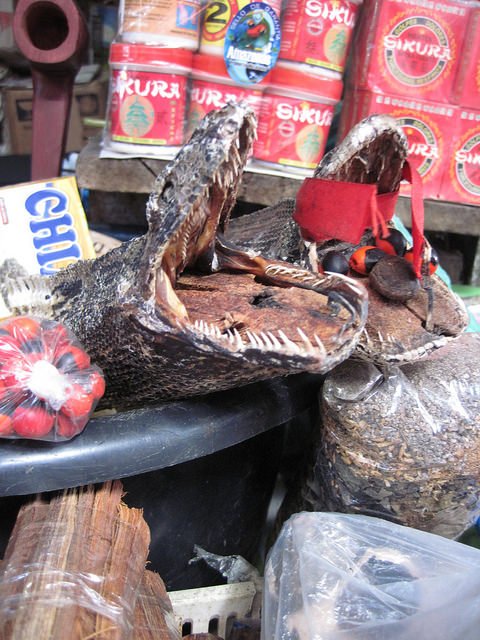
Dried Anaconda heads in the Belen Markets
Deep in the Peruvian Amazon you'll find a city with no roads to the outside world, where the fast expanding population rubs uncomfortably against one of the most bio-diverse areas on the planet. This is the setting for one of the craziest, saddening and eye opening places I've been in my years of traveling the far corners of the globe.
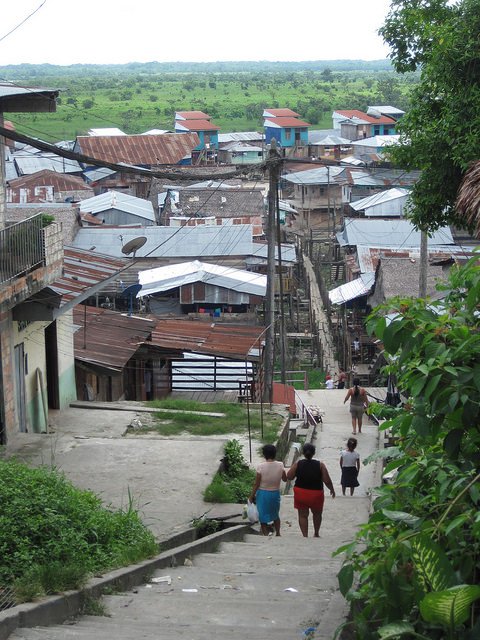
Belen in the low water season. During the high water season the slum is partly submerged by the Amazon River
The Mercado Belen (or Belen Markets) are situated on the edge of the Belen slum in Iquitos, Peru, one of the most dangerous parts of an already dangerous area. The slum itself is built on marginal land, below the high water line of the Amazon river in the wet season, meaning the houses are partially submerged for three months of the year. Coupled with the equatorial climate, it becomes a perfect breeding ground for disease and infection. Life in Belen is tough to say the least.
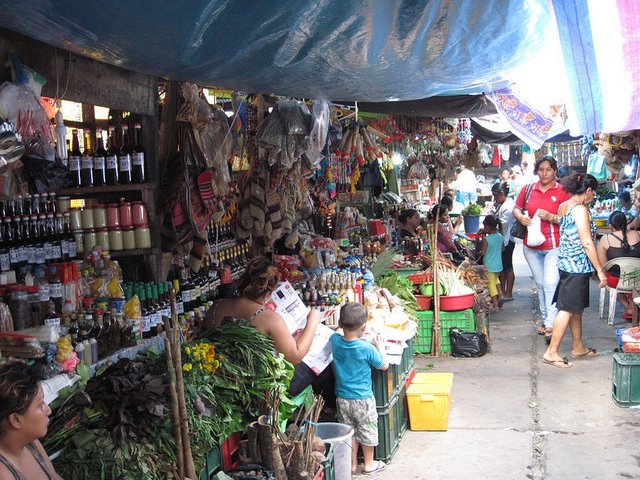
Hundreds of plants and potions line the stalls
Here, just above the high water mark, sitting noisily under blue tarpaulins, corrugated iron and shacks made of anything from shipping crates to palm fronds, lies the Mercado Belen. At first glance from the edge, this looks like a lot of other South American markets; fresh fruit, un-refrigerated meat and counterfeit denim lines the stalls; but look a little deeper and things become unsettling.
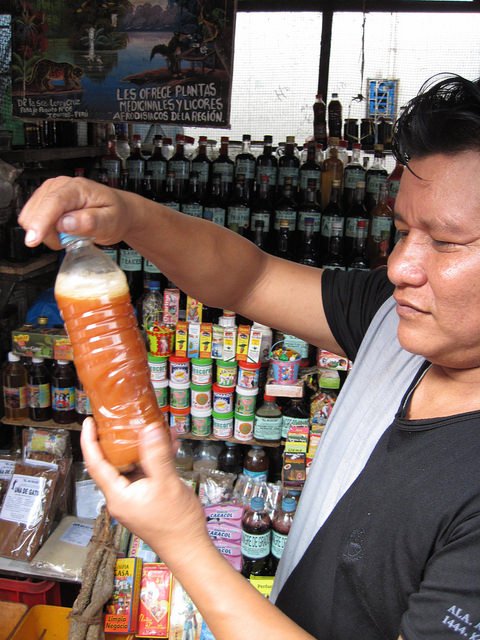
A vendor holds a bottle of Ioaska - a powerful hallucinogen used in religious ceremonies
Going in, we were instructed to take a guide, otherwise we would likely be robbed. This is the first time in all my travels I've taken a guide for security reasons but after talking to a French tourist who was confronted with a machete, and hearing spates of other grapevine stories, we decided it was a good idea. Unfortunately, we saw our decision justified after 15 minutes when a German tourist had his bag slashed with a razorblade just in front of us. He lost everything.
As we ventured past the amazing arrays of tropical fruit our guide darted left down the witchcraft lane. Here we saw the first trappings of what would separate this market from all others. Rows of bottles, wood carvings, powders and bunched leaves crowded the tiny stalls, the unrecognizable names giving the user insect bite relief, strong sex-drive, strong hallucinations, the ability to ward off jungle spirits and to curse disliked neighbors. Some discussion with the vendors revealed the sad truth behind what we were looking at. Powdered jaguar bones and strips of fur. We didn't need to be told what the endangered black caiman and anaconda heads were.
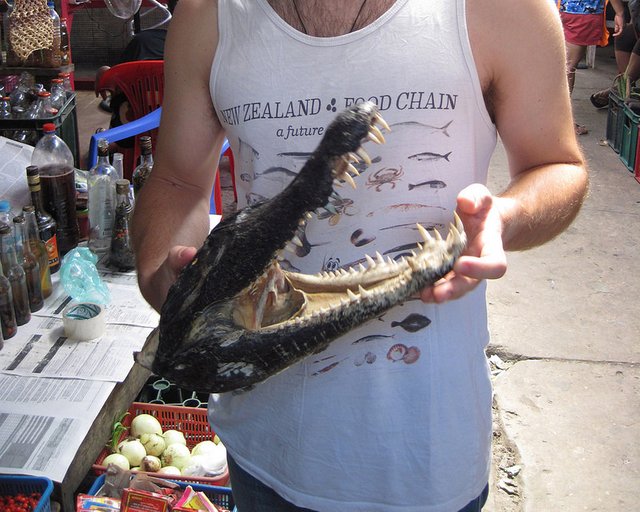
The author holds a dried Black Caiman head. An endangered species
The next stop was the most graphic and disturbing to me. The fresh meat area was the biggest area we could see. Walking past the skin-on caiman tail grilling on a makeshift barbecue was a mild entrance. The standard chicken and beef tables were side-by-side with freshly butchered tortoises, more caiman tails, lizards and snakes. The stench of fish in the tropical heat was almost tangible as we walked towards the fish tables, covered in armored catfish and piranha.
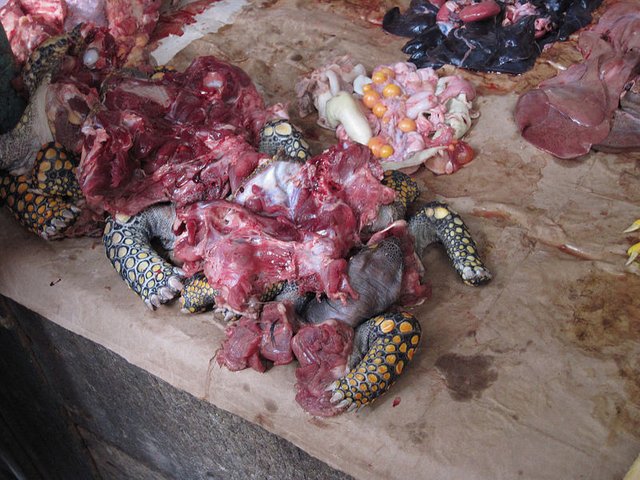
Turtle meat on display
This was a gentle warmup for the final act. Tables of red meat, at a distance, looked like cow or buffalo. But the hacked off limbs, some with the hands and feet still attached, gave away the grim truth that these belonged to monkeys. On one of the tables sat a baby woolly monkey in diapers, among the meat from it's species, and several others. I could buy the baby for the equivalent of US$50 if I so wished.
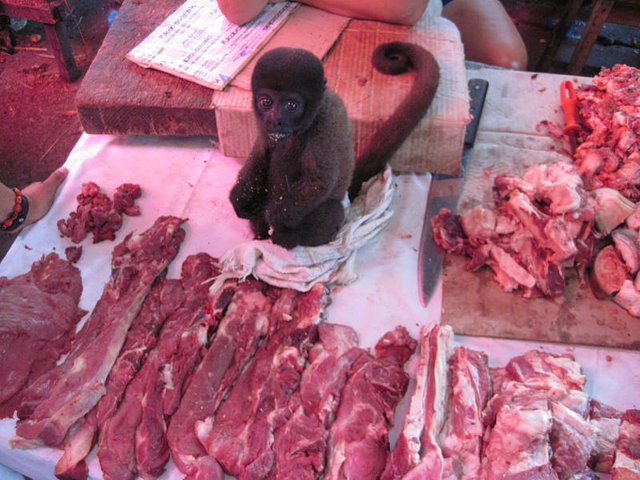
A baby woolly monkey on a butchers table
The bored policemen standing around were testament to the fact that, despite this being considered highly illegal, this is the way of life here. People have been dealing in these products for thousands of years. Only now, with improved river transport and hunting methods, the destruction is much more effective. The burgeoning population hasn't created a new taste for these species, it has just greatly enhanced the demand.
Whilst it was eye-opening, saddening and somewhat perplexing, I had to remind myself that what was happening here is no different to the destruction caused by so many other societies in so many other places. Just because it is not as in-your-face as here, it doesn't make over-fishing of turtles in the Amazon any worse than over-fishing of anything else, like tuna in the Pacific Ocean. It's gory and heart-wrenching but I can't really sit on a high horse and say my society is any better. At least in Mercado Belen you can get a sense of what actually happens and understand the problems in the area.
But you ever wanted to go to the Amazon, I would highly recommend Iquitos as a starting point. The lively culture and proximity to some relatively untouched stretches of jungle are incredible. The Amazon itself is almost beyond comprehension in it's beauty and expanse. And go to the Belen Markets. Get a feel for the issues facing local people and their way of life, it's surely one of the craziest experiences you'll have.
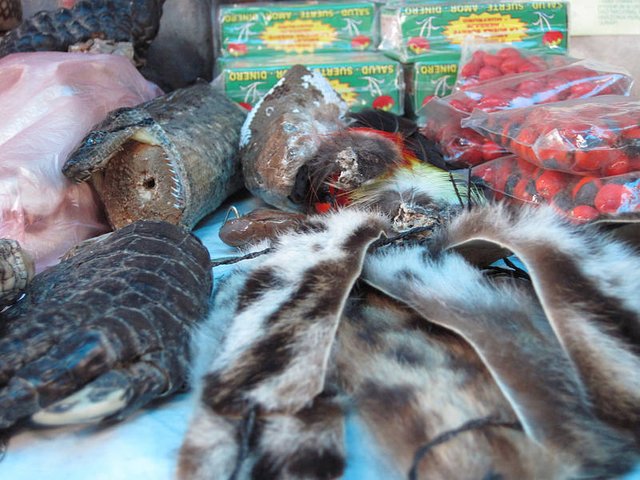
Snakes heads, a caiman foot and jaguar skin for sale
NOTE: These photographs were taken by a fellow traveler during our walk through the markets. We only took one camera for safety reasons.
Absolutely insane!!! I love learning about this underground stuff. Saddening to some extent but these people live under a different paradigm!
Absolutely! I really want to stress how beautiful the area is there, and Ecotourism is really making a difference because locals can make money by protecting the environment rather than destroying it.
For ekotourism you have to go to Pantanal to a lodge with air-conditioning and guides. The land is private property with fence and the owners are aware that tourist bring more many than cattle. It resembles the South Africa attitude.